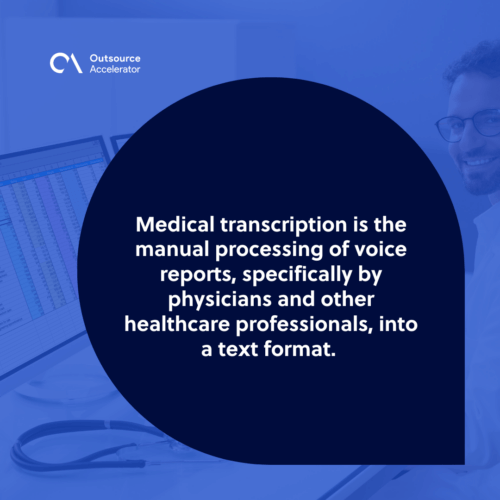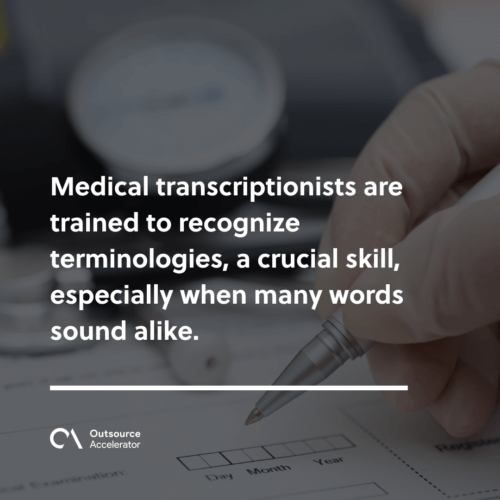Why medical transcription services matter

The healthcare industry stands on a foundation of patient data and medical reports.
Thousands of people consult with their local physicians and other healthcare professionals daily. These interactions must be recorded in a text format for easy reference.
The healthcare industry is increasingly adopting medical transcription services and software to create greater cost-efficiency.
The industry is growing, and outsourcing medical transcriptionists from firms like MVP Asia Pacific allows medical facilities to streamline their business.
What is medical transcription?
Medical transcription is the manual processing of voice reports, specifically by physicians and other healthcare professionals, into a text format. It includes everything from clinical summaries to surgical notes.
It’s more efficient to glance at a text report than listen to a long audio file that gets corrupted over time. A medical transcriptionist or a registered healthcare documentation specialist is usually tasked to convert audio into text for the healthcare providers’ convenience.
They can generate a lot of reports in a day, and often, each must be produced from hurried recordings.

Why do healthcare providers outsource medical transcription
Basically, healthcare providers have the option to hire a certified healthcare documentation specialist or transcriptionist in-house. Most starting practices even do this themselves.
However, retaining and training staff in-house can be time- and resource-consuming for medical facilities dealing with limited resources.
This instance makes outsourcing a reasonable option for them. Aside from better rates, outsourcing gets them skilled transcriptionists more efficiently.
Apart from the reasons mentioned, here are other factors as to why healthcare providers outsource transcription services.
Required training and certifications
Medical transcriptionists must be proficient in a medical facility’s primary language, familiar with medical terminology, and have excellent typing and listening skills.
As proof, some employers look for applicants with certifications through institutions such as Association for Healthcare Documentation Integrity (AHDI).
The shortage of medical transcriptionists in their area, paired with the required investment in their training and certification, can become a burden to small facilities.
Compliances and tools to use
Today, the medical field also relies on speech recognition and medical transcription software. However, hiring certified medical transcriptionists should still be the first choice in terms of compliance.
For one, the existence of HIPAA requires health institutions to protect their patient records. While more recognition tools are built in line with this compliance, medical transcriptionists are more trained to handle medical documents according to standards.
By delegating medical transcription service, healthcare providers can get a skilled staff along with appropriate tools to fulfill their compliance.
Duties involved in medical transcription
Medical transcription doesn’t just mean writing a big block of text from an audio recording.
A medical transcriptionist is also involved in editing and formatting the report, which is then reviewed by a physician. This industry is a growing area like the rest of the medical field.
The main duties of a medical transcriptionist include the following:
Medical history
Physicians will frequently record patients’ medical histories during their consultations and review them later. Medical transcriptionists transcribe medical history reports for a variety of medical specializations.
Data interpretation
Medical transcriptionists interpret and categorize the dictated data into notes, operative reports, patient records, consultations, and discharge summaries.
It’s also the responsibility of the medical transcriptionist to catch doctors’ errors, such as grammatical ones, and correct them in the transcription.
Review transcription software work
Medical facilities that use speech recognition apps usually end up having to hire a medical transcriptionist to review the document. The software can easily mistranscribe many medical terms and lead to inaccurate reports.
A speech recognition app may not be able to differentiate between the words “anuresis” and “enuresis” when spoken
Medical transcriptionists are trained to recognize terminologies, a crucial skill, especially when many words sound alike. They have the context to determine which is correct.
Medical records
Medical transcriptions utilize the medical facility’s Electronic Health Record (EHR) or Electronic Medical Record (EMR) system in a secure digital format. Oftentimes, they will also be given access to input the data records themselves.
Find skilled medical transcriptionists through MVP Asia Pacific
Despite the presence of speech recognition software, medical transcription still works best when done manually.
Software errors require manual reviews of both the transcribed and original audio files, which wastes time and money.
Hiring trained and experienced medical transcriptionists to do the work directly is more efficient and serves as a natural fail-safe. Even within the transcription industry, medical transcription occupies a unique niche, requiring medically-trained workers.
Medical transcription is one of the services you can outsource from MVP Asia Pacific’s healthcare services. You can save valuable resources and dedicate your time to more critical tasks with an outsourced team.
MVP Asia Pacific trains its medical transcription team to interpret medical abbreviations and terminologies. Clients are assured their transcription reports will be taken care of.
The Health Insurance Portability and Accountability Act protects patients’ information from being shared without their consent or knowledge. MVP Asia Pacific is HIPAA-compliant. It ensures that all clients’ medical data is protected and secured.
Contact MVP Asia Pacific today for top-notch medical transcription services.








 Independent
Independent




